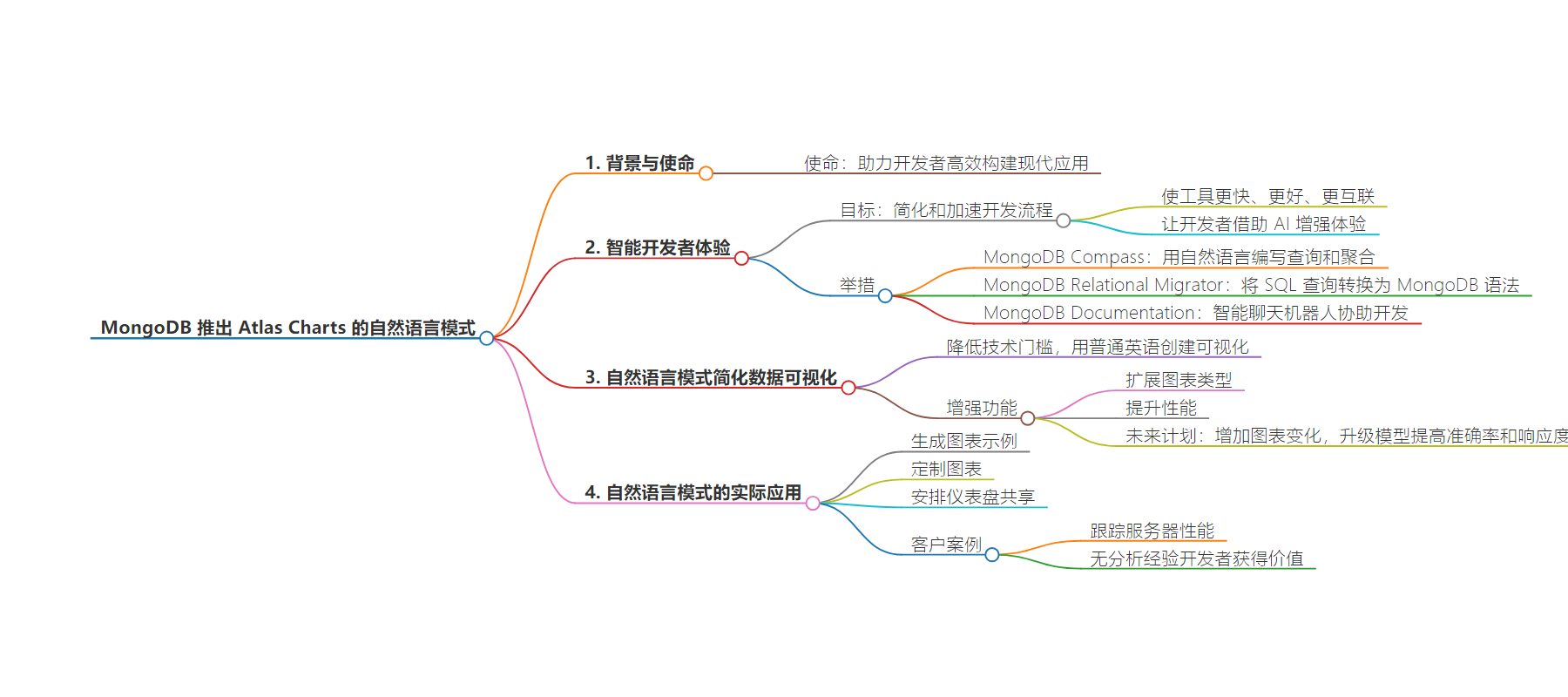包阅导读总结
1. `MongoDB`、`Atlas Charts`、`Natural Language Mode`、`开发者`、`数据可视化`
2. MongoDB 宣布 Atlas Charts 中自然语言模式全面可用,该模式能借助 AI 帮助开发者加速工作,简化数据可视化,还介绍了相关智能开发体验及应用实例,客户对其充满期待。
3.
– MongoDB 的使命是助力开发者高效构建现代应用
– 推出一系列工具和改进,如关系迁移器中的 AI 驱动的 SQL 查询转换等
– 宣布 Atlas Charts 中自然语言模式全面可用
– 降低技术门槛,任何人都能通过简单英语提问创建可视化
– 介绍了模式开发后的增强,包括图表类型扩展和性能提升
– 未来几周将有更多升级
– 自然语言模式的实际应用
– 举例展示生成图表、在经典模式中定制图表、安排仪表板共享等
– 客户对其可能性感到兴奋,如跟踪服务器性能等
– 鼓励开发者体验该模式以简化和加速数据可视化工作流
思维导图:
文章地址:https://www.mongodb.com/blog/post/introducing-ai-powered-natural-language-mode-atlas-charts
文章来源:mongodb.com
作者:Jad Jarouche
发布时间:2024/7/29 22:23
语言:英文
总字数:751字
预计阅读时间:4分钟
评分:86分
标签:人工智能驱动的工具,数据可视化,开发人员工作效率,自然语言处理,商业智能
以下为原文内容
本内容来源于用户推荐转载,旨在分享知识与观点,如有侵权请联系删除 联系邮箱 media@ilingban.com
At MongoDB, our mission is to empower developers to seamlessly and efficiently build modern applications. To that end, we’ve announced a number of tools and improvements to help developers build faster, from AI-powered SQL query conversion in Relational Migrator to the MongoDB Provider for Entity Core Framework.
In the same spirit, today at MongoDB.local Sydney we’re excited to announce the general availability of Natural Language Mode in Atlas Charts. Not only does this release help developers move faster with AI, it also showcases the work of MongoDB’s nimble Sydney engineering team.
Intelligent developer experiences: The next level of productivity
Over the past year, we’ve introduced a range of intelligent developer experiences across our platform, all of which aim to simplify and accelerate development processes. Overall, our goal is to make tools faster, better, and more connected for our developers, and to enable developers to leverage the power of AI to enhance their experience.
As IBM highlights, true developer productivity involves delivering high-quality outputs that satisfy customers but also avoid developer burnout.
By reducing learning curves, saving time, and providing easily accessible insights, intelligent features enable developers to focus on their most important work: building modern applications that solve real-world problems through outputs that are truly worth developers’ time and effort.
Here’s what we’ve introduced:
-
MongoDB Compass—Developers can use natural language to compose everything from simple queries to sophisticated, multi-stage aggregations.
-
MongoDB Relational Migrator—With natural language, developers can convert SQL queries to MongoDB Query API syntax, streamlining migration projects.
-
MongoDB Documentation—An intelligent chatbot, built on top of MongoDB Atlas and Atlas Vector Search, enables lightning-fast information discovery and troubleshooting during software development.
By integrating AI into our most important developer tools, we’re helping developers cut through the noise and focus on creating innovative solutions.
Simplifying data visualization with Natural language Mode
Visualizing data can be an incredibly effective way of gleaning insights from application data, but creating effective visualizations can require specialized knowledge and experience with business intelligence (BI) tools. Atlas Charts was built to level the playing field.
Now, with Natural Language Mode, developers can create visualizations simply by asking questions in plain English. Natural Language Mode reduces technical barriers and makes data visualization accessible to anyone with data in MongoDB Atlas. This means faster chart creation at an advanced scale—all within the Atlas ecosystem.
Since announcing its development in the fall of 2023, we’ve made significant enhancements to Natural Language Mode, including an expanded suite of chart types built for all kinds of data from patient records to financial trading flows. We’ve also improved performance to ensure faster and more accurate chart generation, including the ability to handle more sophisticated prompts, filtering, sorting, binning, and limiting.
In the next few weeks, we will add more chart variation, as well as another upgrade to our model that will increase accuracy and responsiveness by up to 50%.
Natural Language Mode in action
Now let’s walk through a few examples of what using Natural Language Mode in an Atlas Charts looks like:
Generating a chart using Natural Language Mode
With a simple query like “Show me the sales performance by country and product for Q4 FY2023,” developers can instantly generate a relevant chart.
VIDEO
Customizing charts in Classic Mode
After generating a chart, developers can pull it into Classic Mode to fine-tune and customize it to fit their dashboard needs.
VIDEO
Scheduling Dashboards
Developers can also schedule their dashboards to be shared via email, ensuring that key stakeholders receive up-to-date insights automatically.
VIDEO
More data, more insights
Customers are already excited about the possibilities of Atlas Charts and Natural Language Mode, from operational analytics to embedded analytics. For example, one of MongoDB’s early customers has been using Natural Language Mode to track server performance across various regions. Business analysts leverage the feature to gain insights into server performance and share these insights internally. They plan to embed these visualizations into their customer portal using the embedding SDK offered by Atlas Charts.
Another customer said: “As a developer with no prior experience in analytics, I was excited to see Natural Language Mode generate a clear value proposition that showcased what the product is capable of. It makes me want to throw more data in the database to get more insights.”
So check out Natural Language Mode in Atlas Charts today, and experience firsthand how AI can simplify and accelerate your data visualization workflows.
